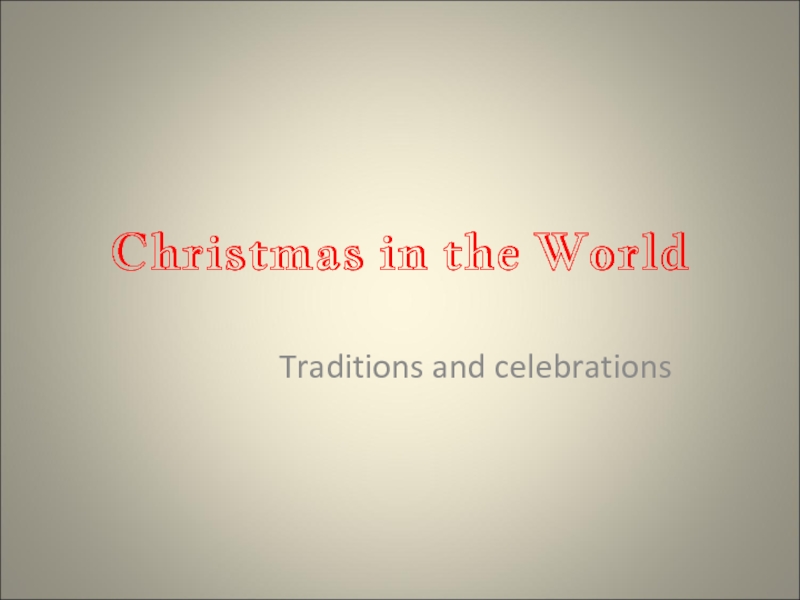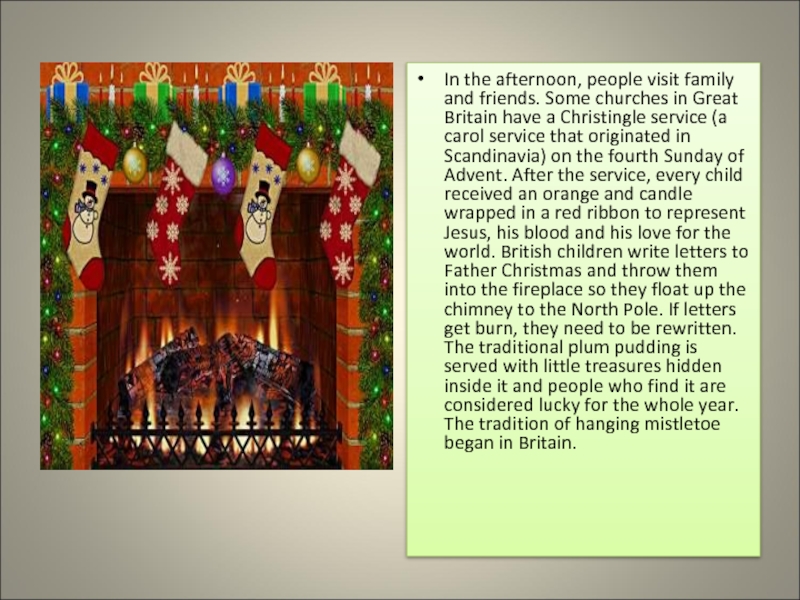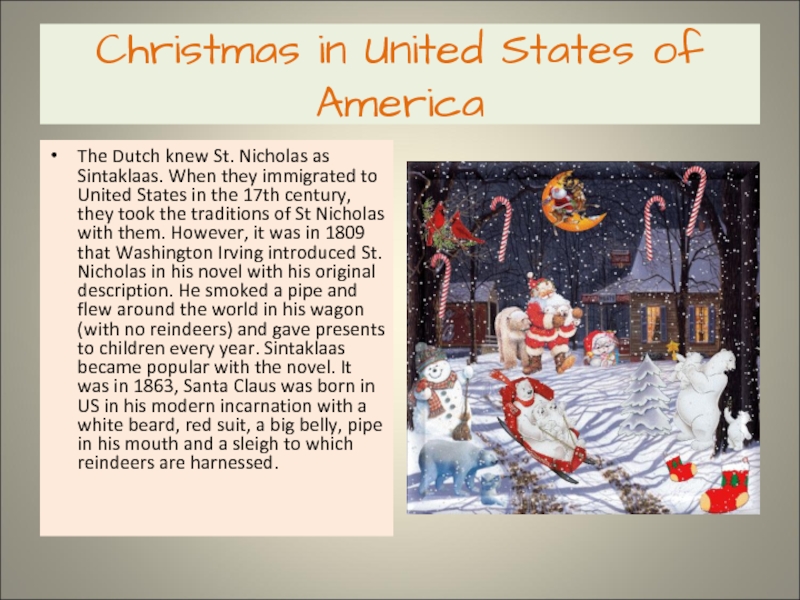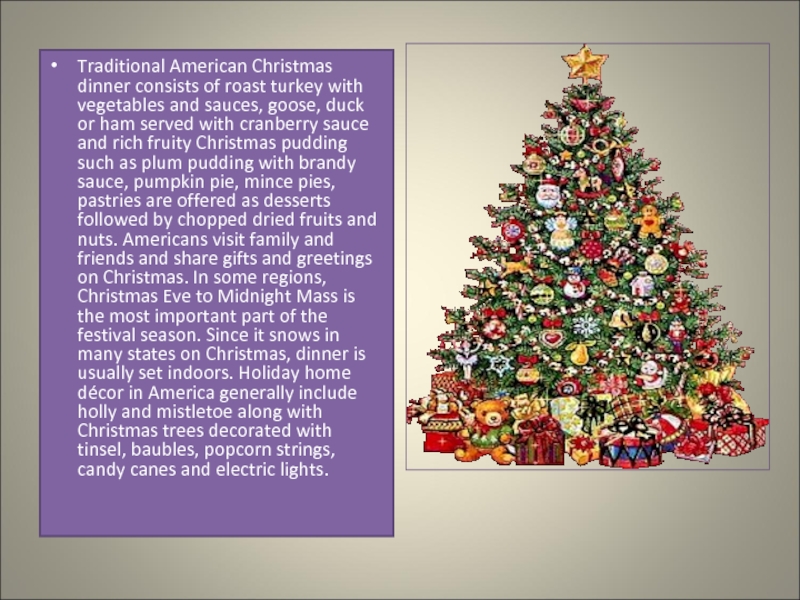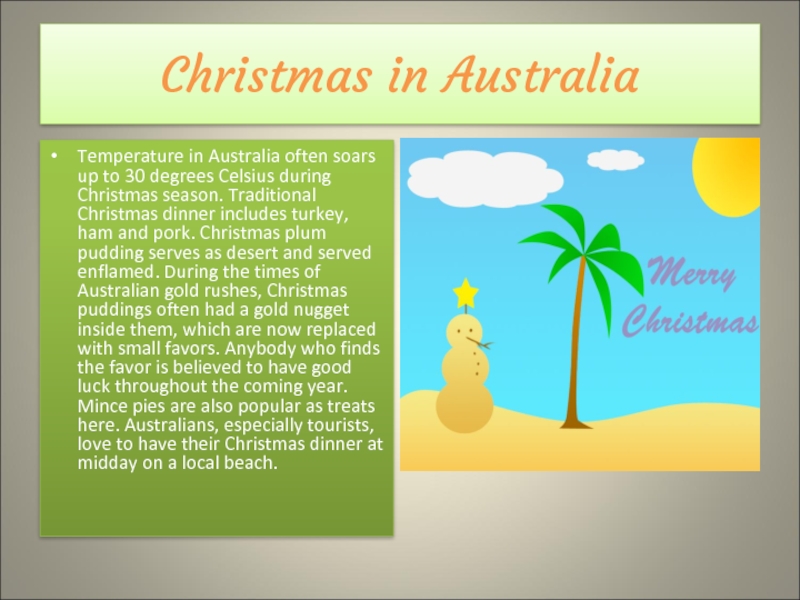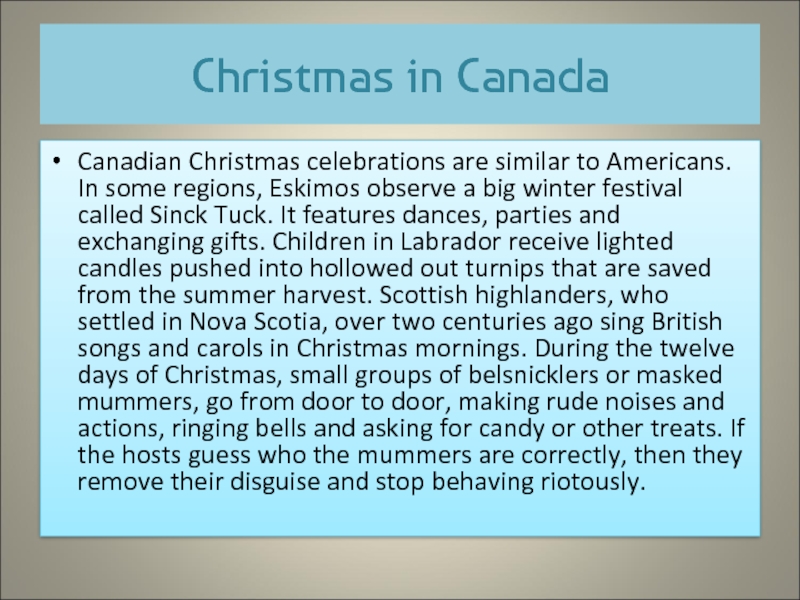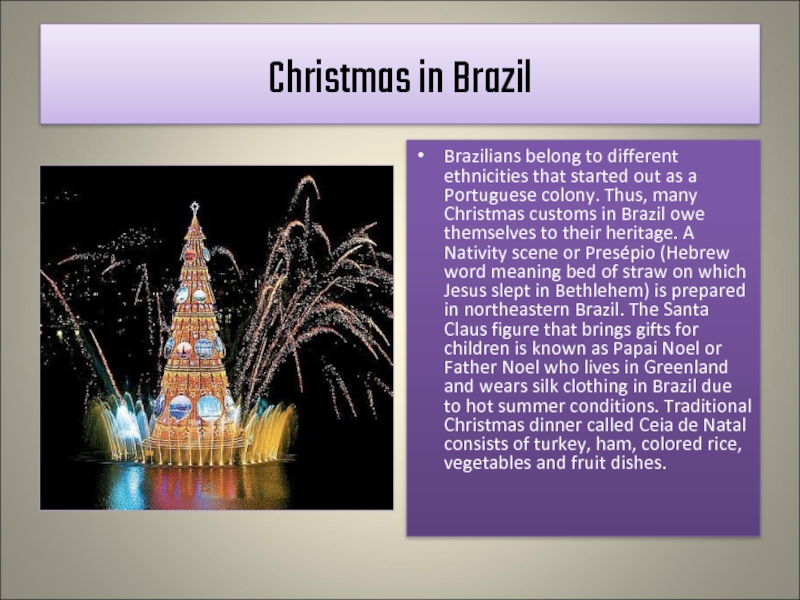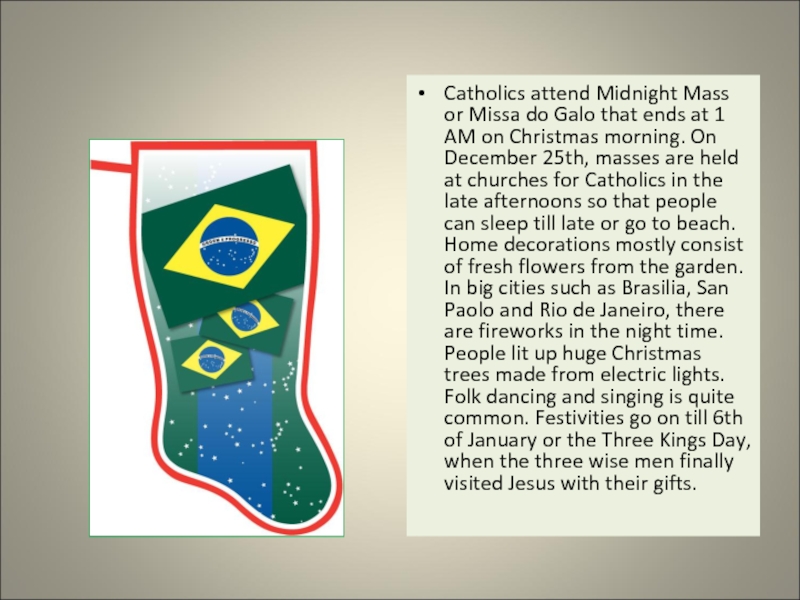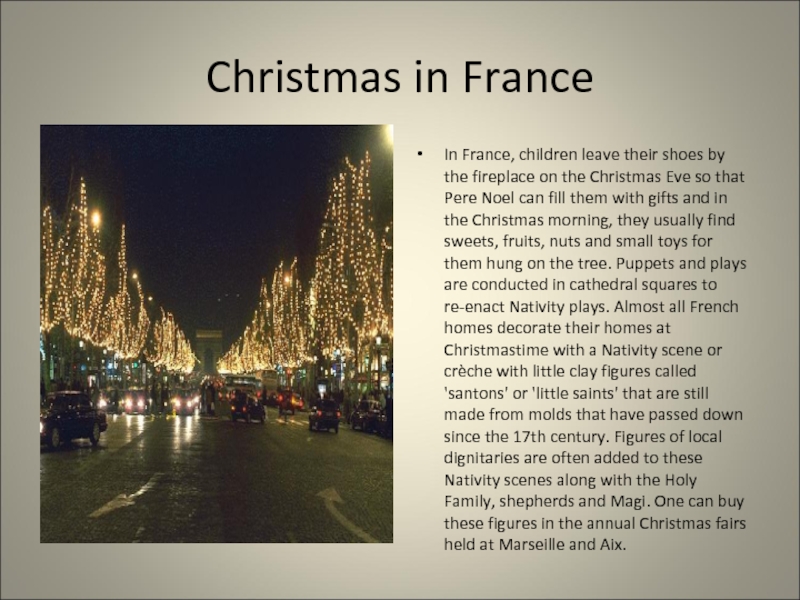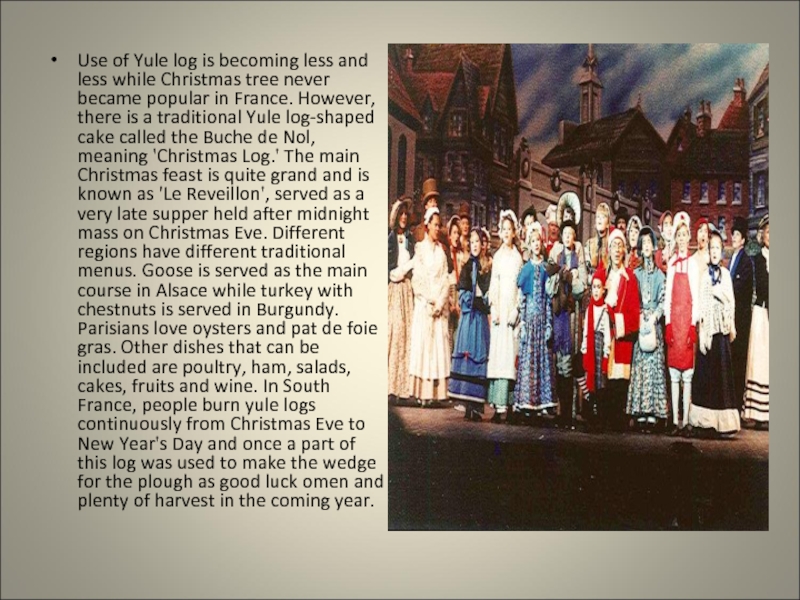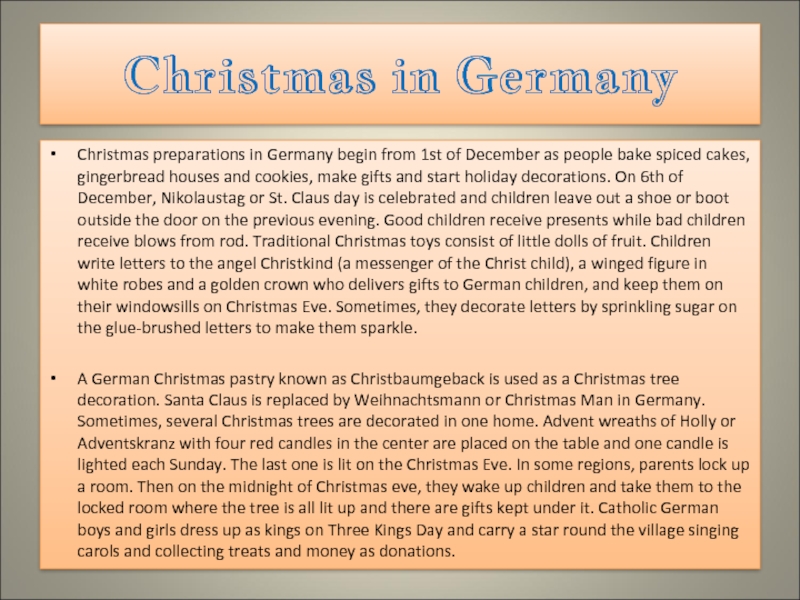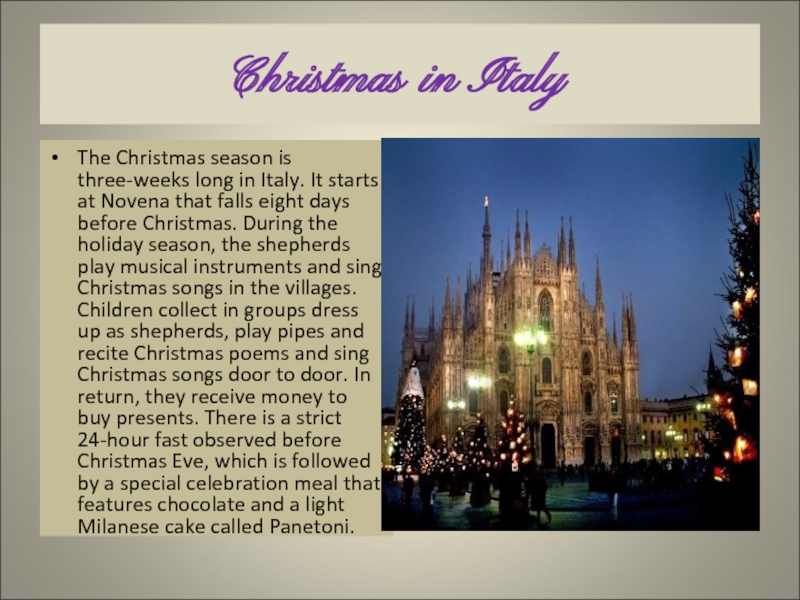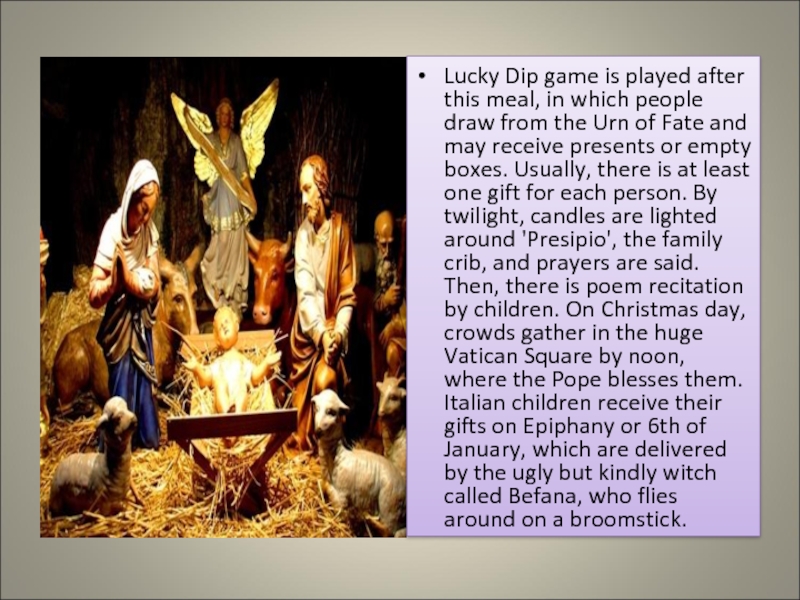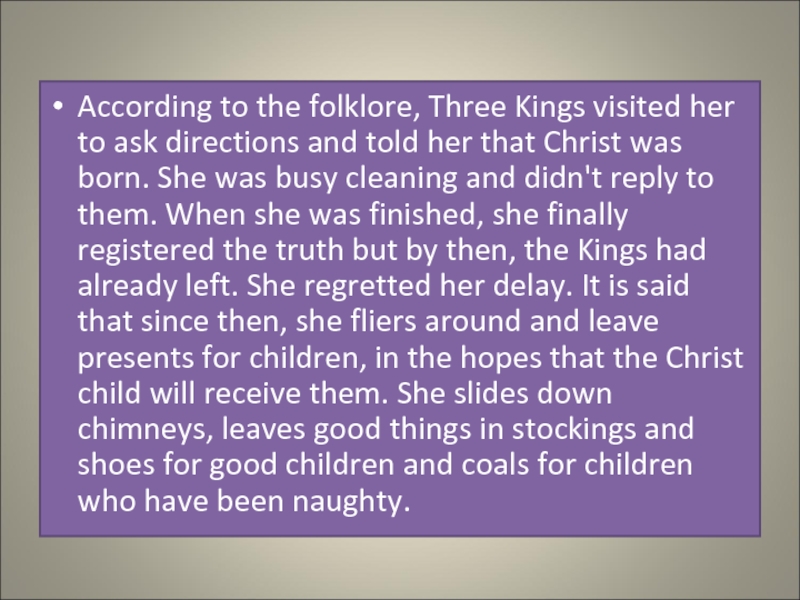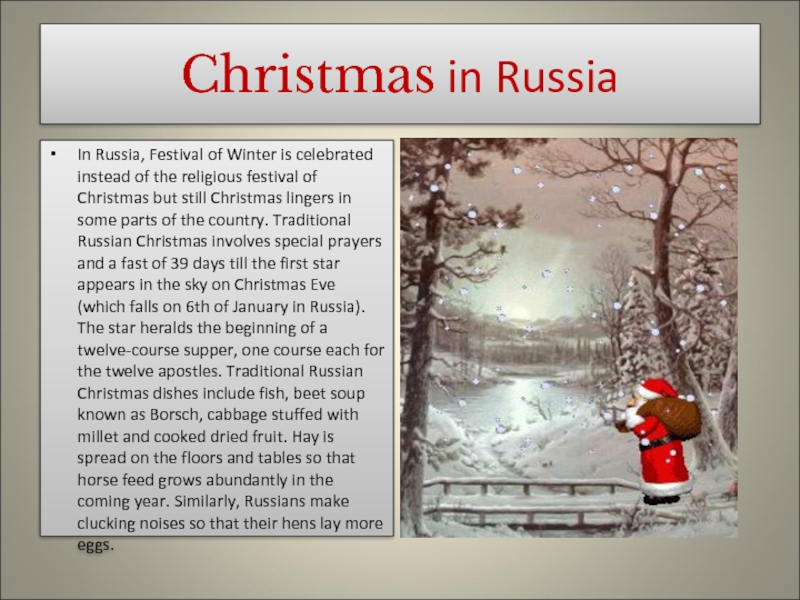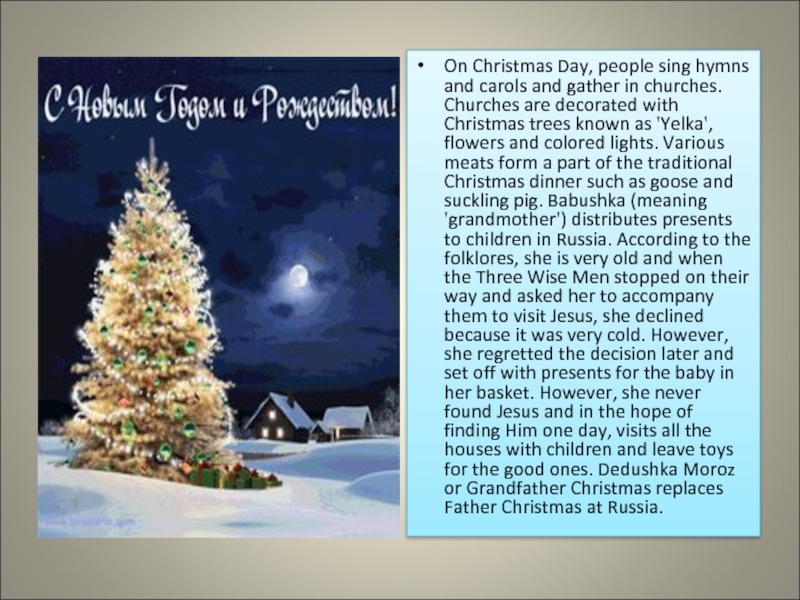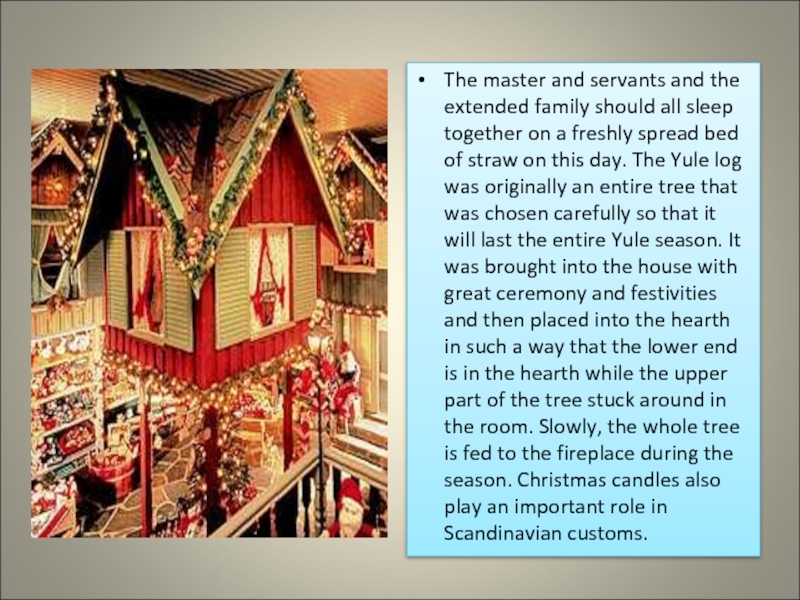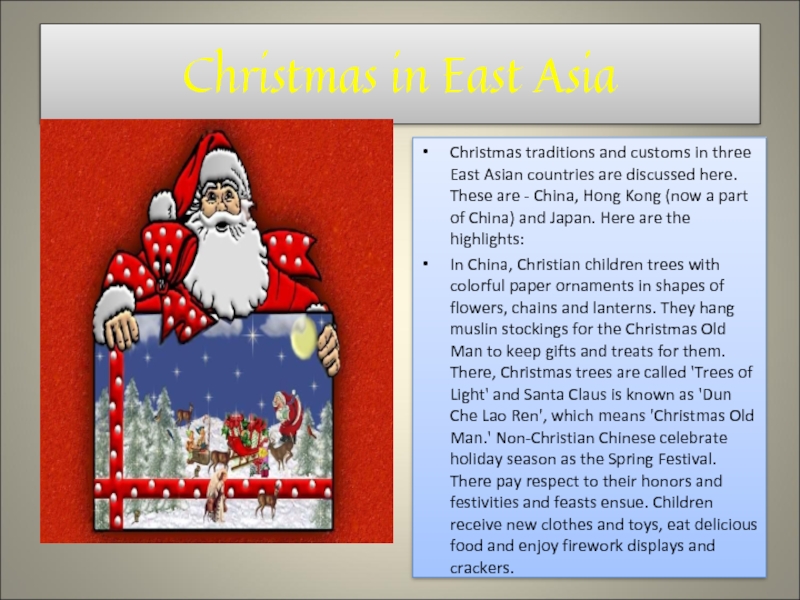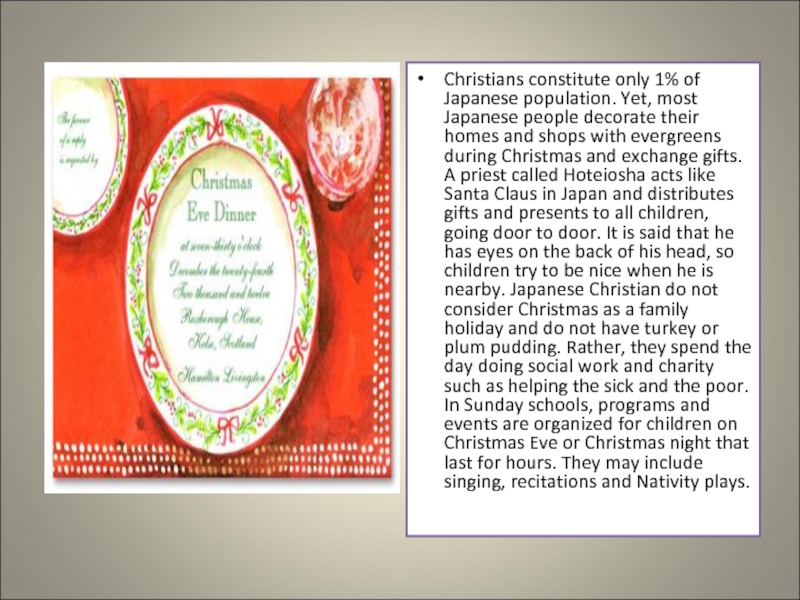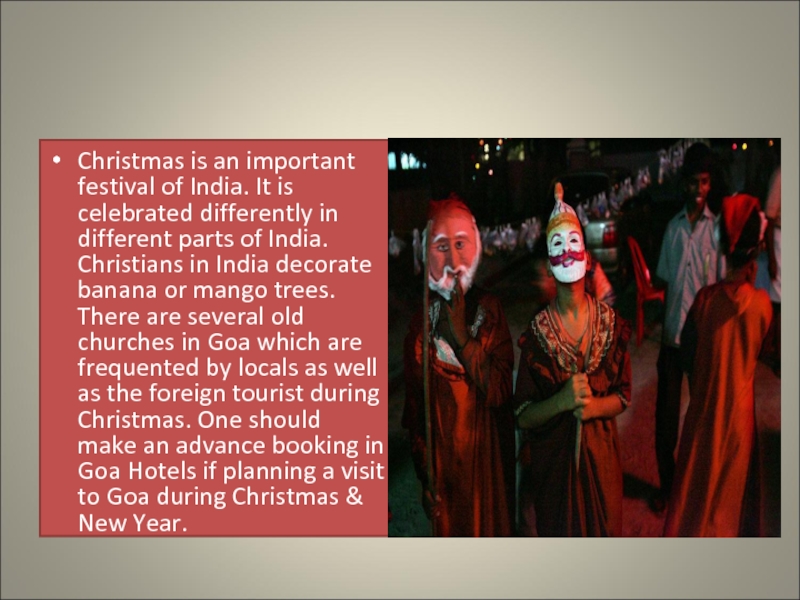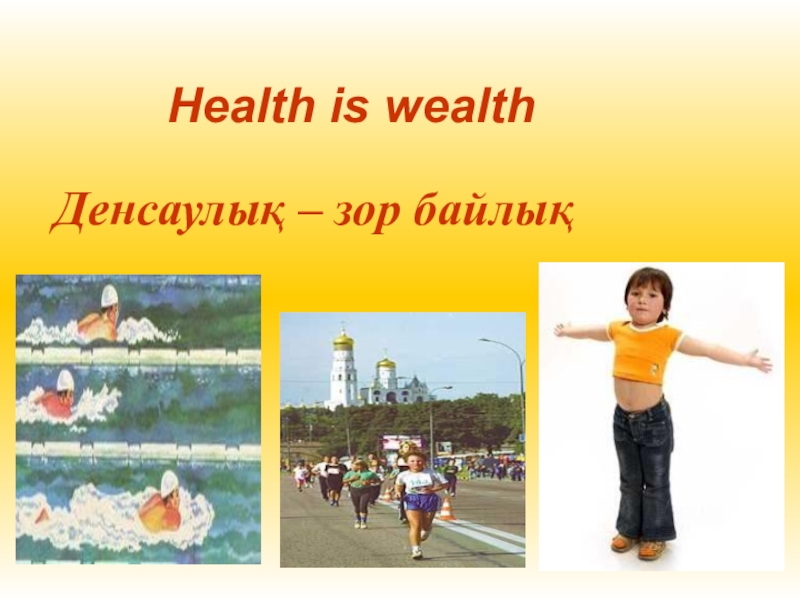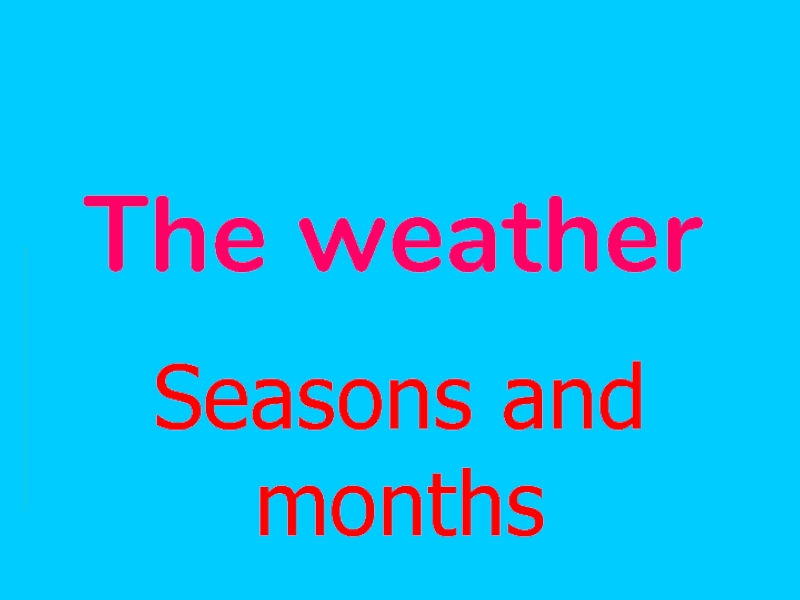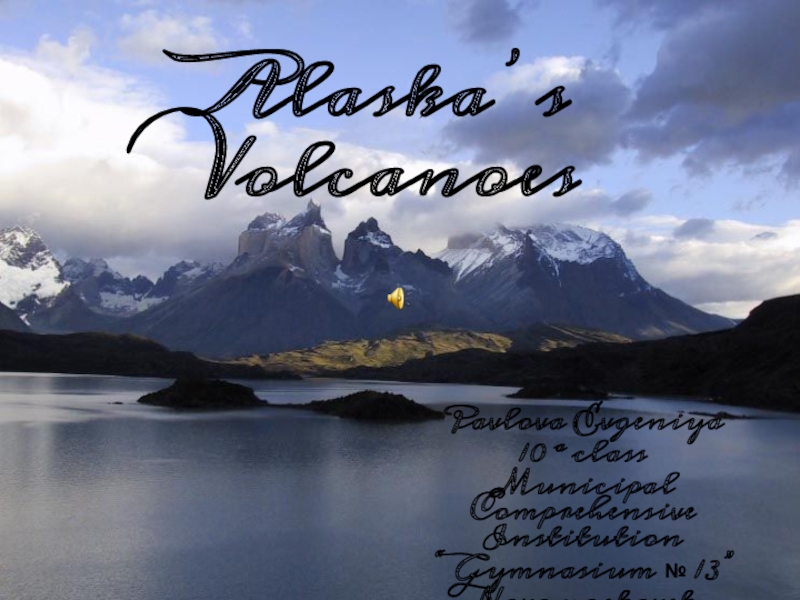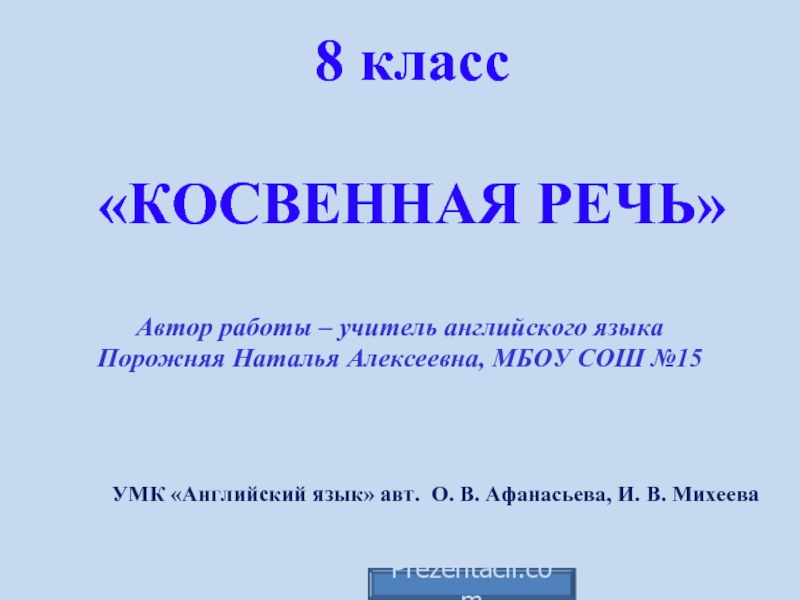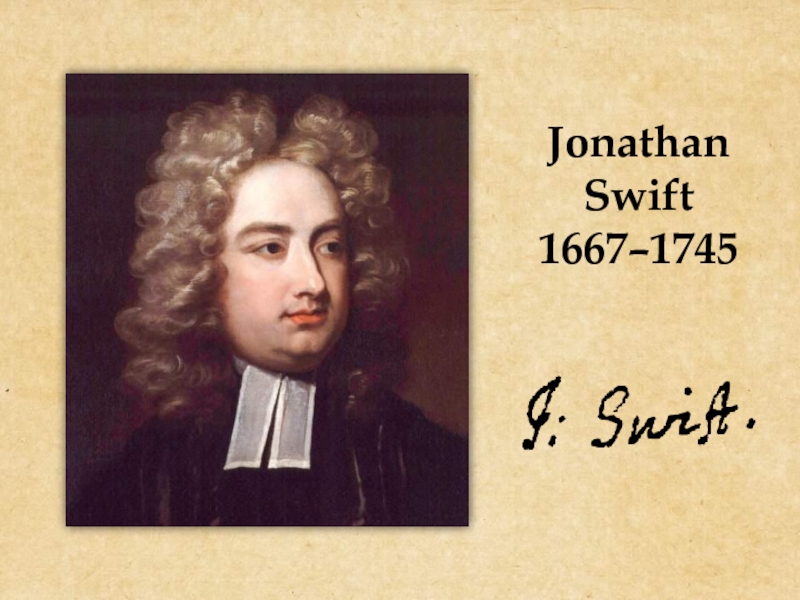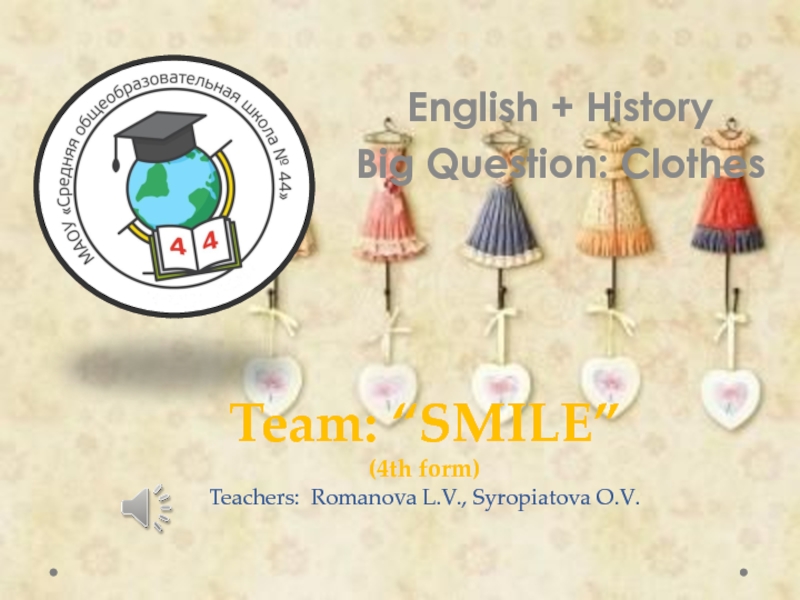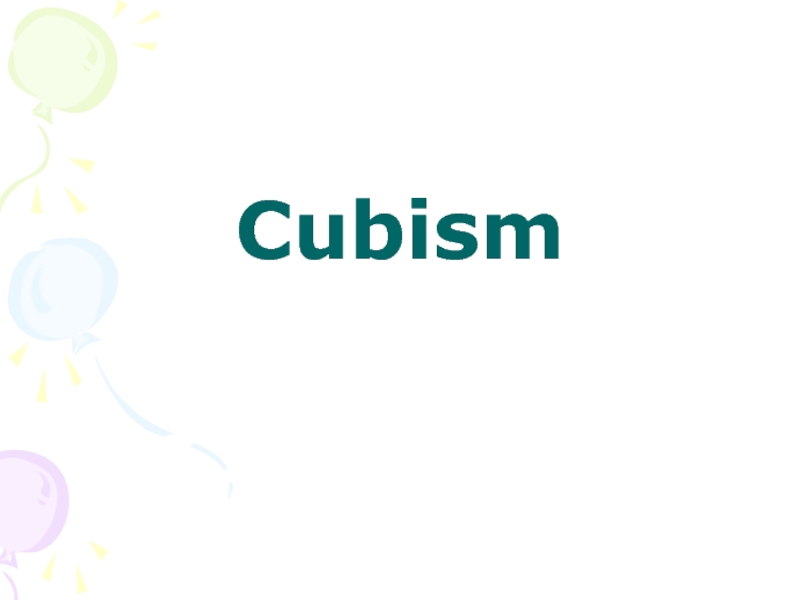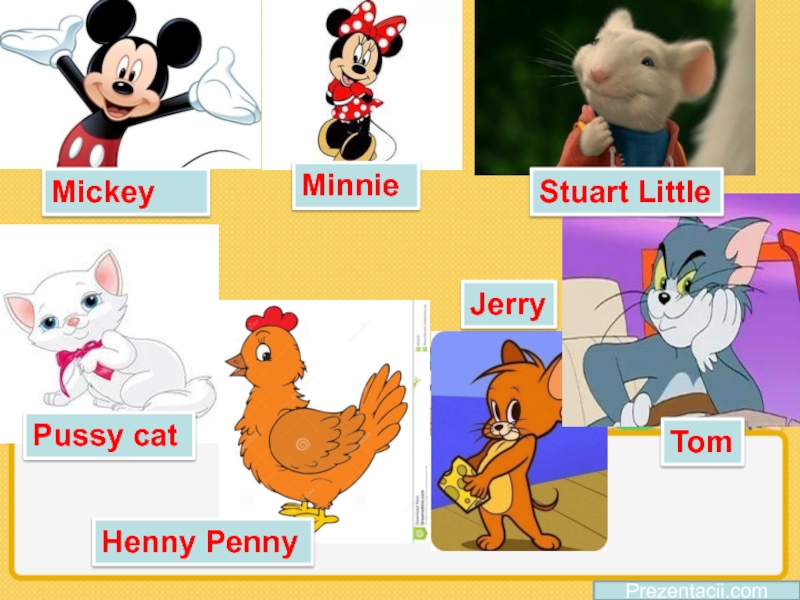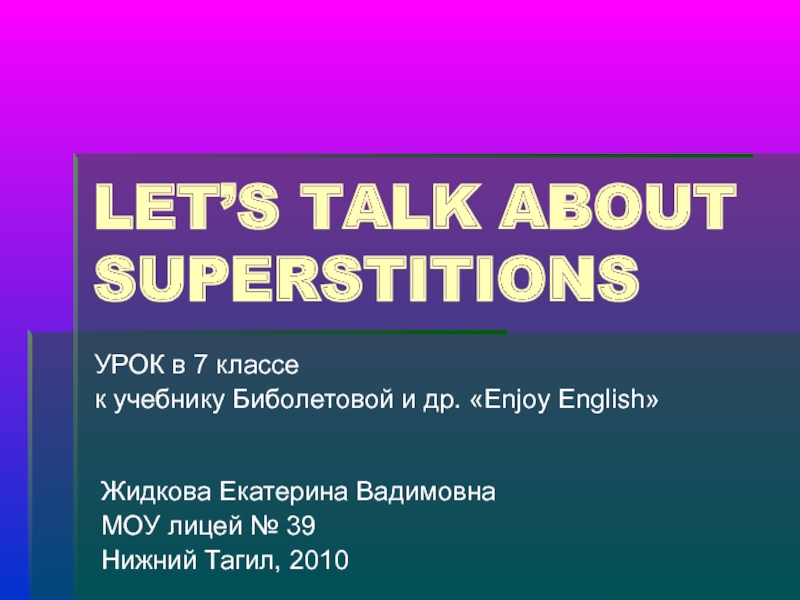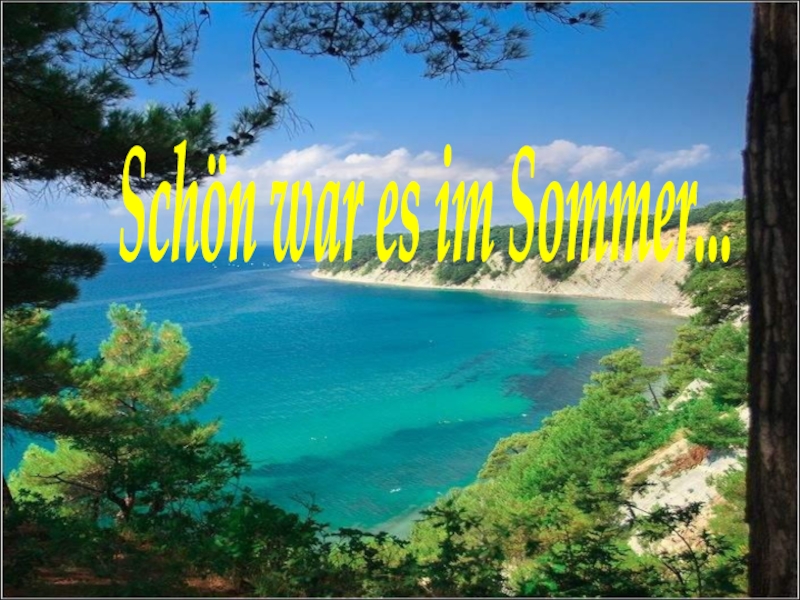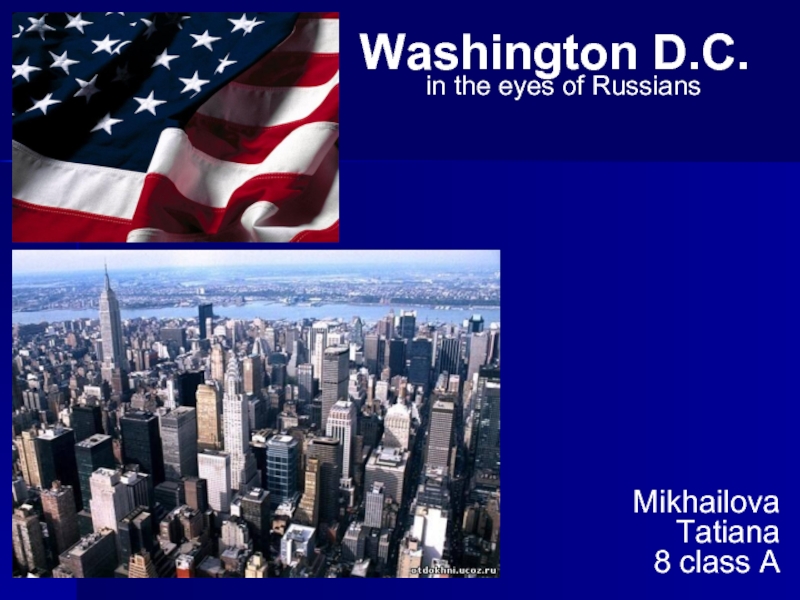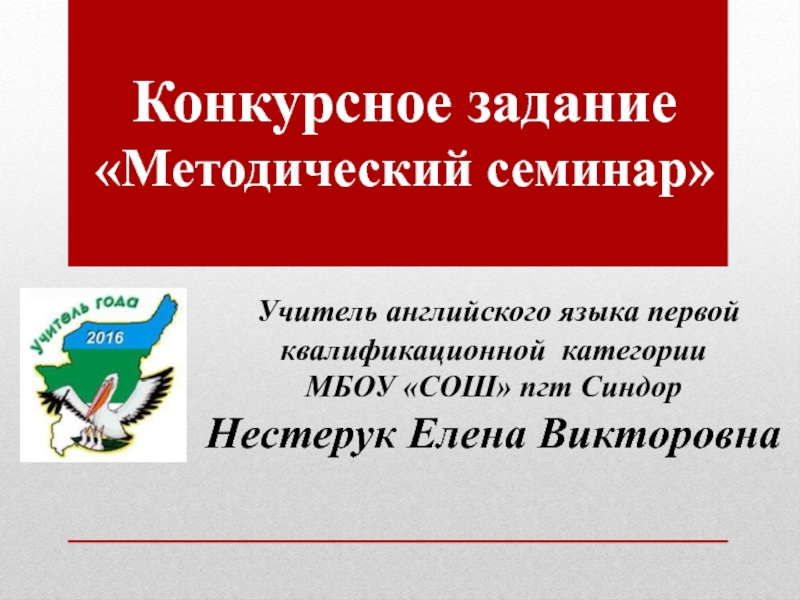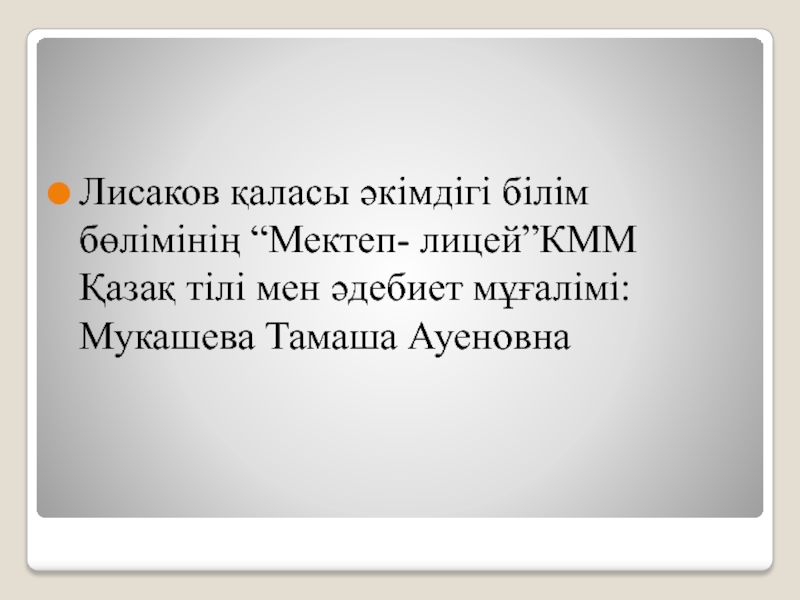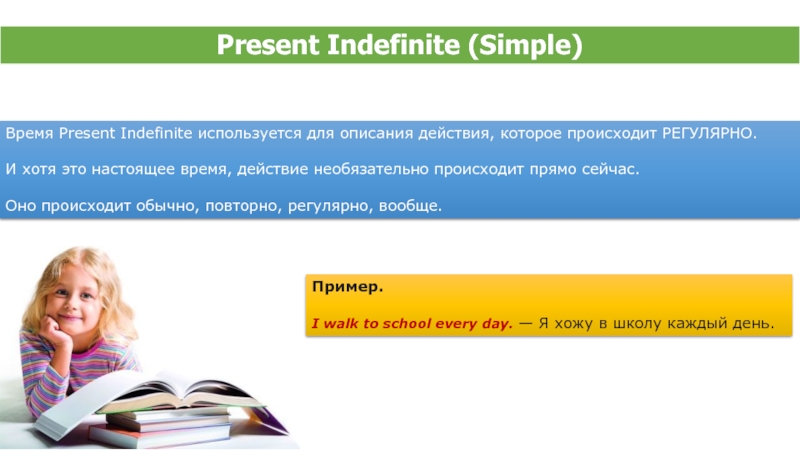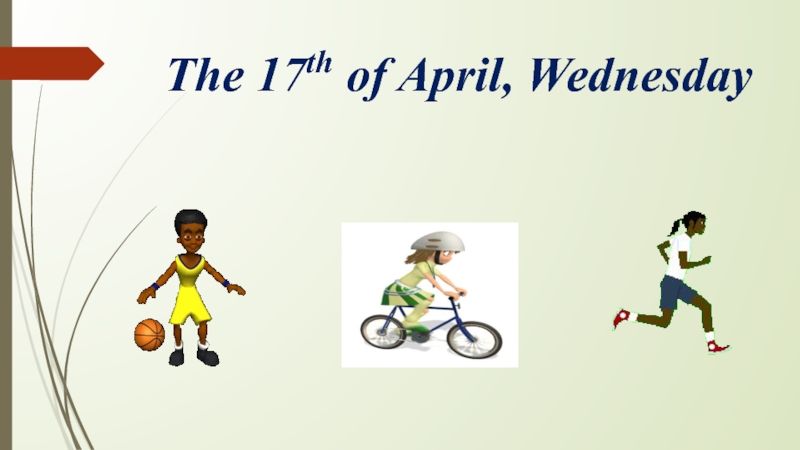Разделы презентаций
- Разное
- Английский язык
- Астрономия
- Алгебра
- Биология
- География
- Геометрия
- Детские презентации
- Информатика
- История
- Литература
- Математика
- Медицина
- Менеджмент
- Музыка
- МХК
- Немецкий язык
- ОБЖ
- Обществознание
- Окружающий мир
- Педагогика
- Русский язык
- Технология
- Физика
- Философия
- Химия
- Шаблоны, картинки для презентаций
- Экология
- Экономика
- Юриспруденция
Christmas in the World
Содержание
- 1. Christmas in the World
- 2. Christmas in Great BritainIn Great Britain, Christmas
- 3. In the afternoon, people visit family and
- 4. Christmas in United States of AmericaThe Dutch
- 5. Traditional American Christmas dinner consists of roast
- 6. Christmas in AustraliaTemperature in Australia often soars
- 7. The hot favorite beach for the purpose
- 8. Christmas in CanadaCanadian Christmas celebrations are similar
- 9. Слайд 9
- 10. Christmas in BrazilBrazilians belong to different ethnicities
- 11. Catholics attend Midnight Mass or Missa do
- 12. Christmas in FranceIn France, children leave their
- 13. Use of Yule log is becoming less
- 14. French families also bake a Three Kings
- 15. Christmas in GermanyChristmas preparations in Germany begin
- 16. Слайд 16
- 17. Christmas in ItalyThe Christmas season is three-weeks
- 18. Lucky Dip game is played after this
- 19. According to the folklore, Three Kings visited
- 20. Christmas in RussiaIn Russia, Festival of Winter
- 21. On Christmas Day, people sing hymns and
- 22. Christmas in ScandinaviaIn Scandinavia, children keep a
- 23. The master and servants and the extended
- 24. Christmas in East AsiaChristmas traditions and customs
- 25. Слайд 25
- 26. Christians constitute only 1% of Japanese population.
- 27. Christmas is an important festival of India.
- 28. Скачать презентанцию
Christmas in Great BritainIn Great Britain, Christmas celebrations continue until the Twelfth Night. Preparing foods, sending Christmas cards, house and church decorations and wrapping up gifts keep everyone busy. On Christmas
Слайды и текст этой презентации
Слайд 3In the afternoon, people visit family and friends. Some churches
in Great Britain have a Christingle service (a carol service
that originated in Scandinavia) on the fourth Sunday of Advent. After the service, every child received an orange and candle wrapped in a red ribbon to represent Jesus, his blood and his love for the world. British children write letters to Father Christmas and throw them into the fireplace so they float up the chimney to the North Pole. If letters get burn, they need to be rewritten. The traditional plum pudding is served with little treasures hidden inside it and people who find it are considered lucky for the whole year. The tradition of hanging mistletoe began in Britain.Слайд 4Christmas in United States of America
The Dutch knew St. Nicholas
as Sintaklaas. When they immigrated to United States in the
17th century, they took the traditions of St Nicholas with them. However, it was in 1809 that Washington Irving introduced St. Nicholas in his novel with his original description. He smoked a pipe and flew around the world in his wagon (with no reindeers) and gave presents to children every year. Sintaklaas became popular with the novel. It was in 1863, Santa Claus was born in US in his modern incarnation with a white beard, red suit, a big belly, pipe in his mouth and a sleigh to which reindeers are harnessed.Слайд 5Traditional American Christmas dinner consists of roast turkey with vegetables
and sauces, goose, duck or ham served with cranberry sauce
and rich fruity Christmas pudding such as plum pudding with brandy sauce, pumpkin pie, mince pies, pastries are offered as desserts followed by chopped dried fruits and nuts. Americans visit family and friends and share gifts and greetings on Christmas. In some regions, Christmas Eve to Midnight Mass is the most important part of the festival season. Since it snows in many states on Christmas, dinner is usually set indoors. Holiday home décor in America generally include holly and mistletoe along with Christmas trees decorated with tinsel, baubles, popcorn strings, candy canes and electric lights.Слайд 6Christmas in Australia
Temperature in Australia often soars up to 30
degrees Celsius during Christmas season. Traditional Christmas dinner includes turkey,
ham and pork. Christmas plum pudding serves as desert and served enflamed. During the times of Australian gold rushes, Christmas puddings often had a gold nugget inside them, which are now replaced with small favors. Anybody who finds the favor is believed to have good luck throughout the coming year. Mince pies are also popular as treats here. Australians, especially tourists, love to have their Christmas dinner at midday on a local beach.Слайд 7The hot favorite beach for the purpose is the Bondi
Beach situated in Sydney's eastern suburbs. Many families enjoy picnics
together or spend their days swimming in pools, playing Cricket or indulging in other outdoor activities.A new Australian tradition was evolved in 1937. On Christmas Eve, thousands of people used to gather in the city of Melbourne for the 'Carols by Candlelight' event and to sing their favorite Christmas songs. All members have a lit candle in their hands and it seems that the stars have come down on Earth from the Sky. In the weeks before Christmas, similar events are arranged in Sydney and the other capital cities. Christmas Bush, a native plant with little red flowered leaves, is used to decorate the houses. People indulge in Christmas shopping and one can see Santa Claus on beaches on a surfboard or a surf lifesaving boat.
Слайд 8Christmas in Canada
Canadian Christmas celebrations are similar to Americans. In
some regions, Eskimos observe a big winter festival called Sinck
Tuck. It features dances, parties and exchanging gifts. Children in Labrador receive lighted candles pushed into hollowed out turnips that are saved from the summer harvest. Scottish highlanders, who settled in Nova Scotia, over two centuries ago sing British songs and carols in Christmas mornings. During the twelve days of Christmas, small groups of belsnicklers or masked mummers, go from door to door, making rude noises and actions, ringing bells and asking for candy or other treats. If the hosts guess who the mummers are correctly, then they remove their disguise and stop behaving riotously.Слайд 10Christmas in Brazil
Brazilians belong to different ethnicities that started out
as a Portuguese colony. Thus, many Christmas customs in Brazil
owe themselves to their heritage. A Nativity scene or Presépio (Hebrew word meaning bed of straw on which Jesus slept in Bethlehem) is prepared in northeastern Brazil. The Santa Claus figure that brings gifts for children is known as Papai Noel or Father Noel who lives in Greenland and wears silk clothing in Brazil due to hot summer conditions. Traditional Christmas dinner called Ceia de Natal consists of turkey, ham, colored rice, vegetables and fruit dishes.Слайд 11Catholics attend Midnight Mass or Missa do Galo that ends
at 1 AM on Christmas morning. On December 25th, masses
are held at churches for Catholics in the late afternoons so that people can sleep till late or go to beach. Home decorations mostly consist of fresh flowers from the garden. In big cities such as Brasilia, San Paolo and Rio de Janeiro, there are fireworks in the night time. People lit up huge Christmas trees made from electric lights. Folk dancing and singing is quite common. Festivities go on till 6th of January or the Three Kings Day, when the three wise men finally visited Jesus with their gifts.Слайд 12Christmas in France
In France, children leave their shoes by the
fireplace on the Christmas Eve so that Pere Noel can
fill them with gifts and in the Christmas morning, they usually find sweets, fruits, nuts and small toys for them hung on the tree. Puppets and plays are conducted in cathedral squares to re-enact Nativity plays. Almost all French homes decorate their homes at Christmastime with a Nativity scene or crèche with little clay figures called 'santons' or 'little saints' that are still made from molds that have passed down since the 17th century. Figures of local dignitaries are often added to these Nativity scenes along with the Holy Family, shepherds and Magi. One can buy these figures in the annual Christmas fairs held at Marseille and Aix.Слайд 13Use of Yule log is becoming less and less while
Christmas tree never became popular in France. However, there is
a traditional Yule log-shaped cake called the Buche de Nol, meaning 'Christmas Log.' The main Christmas feast is quite grand and is known as 'Le Reveillon', served as a very late supper held after midnight mass on Christmas Eve. Different regions have different traditional menus. Goose is served as the main course in Alsace while turkey with chestnuts is served in Burgundy. Parisians love oysters and pat de foie gras. Other dishes that can be included are poultry, ham, salads, cakes, fruits and wine. In South France, people burn yule logs continuously from Christmas Eve to New Year's Day and once a part of this log was used to make the wedge for the plough as good luck omen and plenty of harvest in the coming year.Слайд 14French families also bake a Three Kings Cake with a
bean hidden in it on the Twelfth Day. The lucky
person to find the bean in their slice is crowned the King or Queen, for the day. Children look for the Kings and offer them the gifts of hay for the camels. Last night of the holiday was celebrated as the Feast of Fools and only after that the Lord of Misrule could give up his crown. There are family gatherings during the holiday season. Churches and cathedrals are decorated beautifully and Christmas carols are sung and church bells are rung. After the dinner, the family leaves the fire burning and food and drink on the table for Virgin Mary. In northern France, children get gifts on St. Nicholas' Day instead of Christmas Day while adults share presents on New Year's Day.Слайд 15Christmas in Germany
Christmas preparations in Germany begin from 1st of
December as people bake spiced cakes, gingerbread houses and cookies,
make gifts and start holiday decorations. On 6th of December, Nikolaustag or St. Claus day is celebrated and children leave out a shoe or boot outside the door on the previous evening. Good children receive presents while bad children receive blows from rod. Traditional Christmas toys consist of little dolls of fruit. Children write letters to the angel Christkind (a messenger of the Christ child), a winged figure in white robes and a golden crown who delivers gifts to German children, and keep them on their windowsills on Christmas Eve. Sometimes, they decorate letters by sprinkling sugar on the glue-brushed letters to make them sparkle.A German Christmas pastry known as Christbaumgeback is used as a Christmas tree decoration. Santa Claus is replaced by Weihnachtsmann or Christmas Man in Germany. Sometimes, several Christmas trees are decorated in one home. Advent wreaths of Holly or Adventskranz with four red candles in the center are placed on the table and one candle is lighted each Sunday. The last one is lit on the Christmas Eve. In some regions, parents lock up a room. Then on the midnight of Christmas eve, they wake up children and take them to the locked room where the tree is all lit up and there are gifts kept under it. Catholic German boys and girls dress up as kings on Three Kings Day and carry a star round the village singing carols and collecting treats and money as donations.
Слайд 17Christmas in Italy
The Christmas season is three-weeks long in Italy.
It starts at Novena that falls eight days before Christmas.
During the holiday season, the shepherds play musical instruments and sing Christmas songs in the villages. Children collect in groups dress up as shepherds, play pipes and recite Christmas poems and sing Christmas songs door to door. In return, they receive money to buy presents. There is a strict 24-hour fast observed before Christmas Eve, which is followed by a special celebration meal that features chocolate and a light Milanese cake called Panetoni.Слайд 18Lucky Dip game is played after this meal, in which
people draw from the Urn of Fate and may receive
presents or empty boxes. Usually, there is at least one gift for each person. By twilight, candles are lighted around 'Presipio', the family crib, and prayers are said. Then, there is poem recitation by children. On Christmas day, crowds gather in the huge Vatican Square by noon, where the Pope blesses them. Italian children receive their gifts on Epiphany or 6th of January, which are delivered by the ugly but kindly witch called Befana, who flies around on a broomstick.Слайд 19According to the folklore, Three Kings visited her to ask
directions and told her that Christ was born. She was
busy cleaning and didn't reply to them. When she was finished, she finally registered the truth but by then, the Kings had already left. She regretted her delay. It is said that since then, she fliers around and leave presents for children, in the hopes that the Christ child will receive them. She slides down chimneys, leaves good things in stockings and shoes for good children and coals for children who have been naughty.Слайд 20Christmas in Russia
In Russia, Festival of Winter is celebrated instead
of the religious festival of Christmas but still Christmas lingers
in some parts of the country. Traditional Russian Christmas involves special prayers and a fast of 39 days till the first star appears in the sky on Christmas Eve (which falls on 6th of January in Russia). The star heralds the beginning of a twelve-course supper, one course each for the twelve apostles. Traditional Russian Christmas dishes include fish, beet soup known as Borsch, cabbage stuffed with millet and cooked dried fruit. Hay is spread on the floors and tables so that horse feed grows abundantly in the coming year. Similarly, Russians make clucking noises so that their hens lay more eggs.Слайд 21On Christmas Day, people sing hymns and carols and gather
in churches. Churches are decorated with Christmas trees known as
'Yelka', flowers and colored lights. Various meats form a part of the traditional Christmas dinner such as goose and suckling pig. Babushka (meaning 'grandmother') distributes presents to children in Russia. According to the folklores, she is very old and when the Three Wise Men stopped on their way and asked her to accompany them to visit Jesus, she declined because it was very cold. However, she regretted the decision later and set off with presents for the baby in her basket. However, she never found Jesus and in the hope of finding Him one day, visits all the houses with children and leave toys for the good ones. Dedushka Moroz or Grandfather Christmas replaces Father Christmas at Russia.Слайд 22Christmas in Scandinavia
In Scandinavia, children keep a bowl of porridge
for the little gnome called Julenisse who live in the
attics, so that he won't play pranks on the family and leave presents for them under the Christmas tree in the night. Yule log traditions originated here. Yuletide or the winter solstice is quite important for Scandinavian people as nights become cold and dark in the winters. Thus, most of the traditions and customs are meant to give light and warmth. According to the local superstition, it is dangerous to sleep alone on Christmas Eve.Слайд 23The master and servants and the extended family should all
sleep together on a freshly spread bed of straw on
this day. The Yule log was originally an entire tree that was chosen carefully so that it will last the entire Yule season. It was brought into the house with great ceremony and festivities and then placed into the hearth in such a way that the lower end is in the hearth while the upper part of the tree stuck around in the room. Slowly, the whole tree is fed to the fireplace during the season. Christmas candles also play an important role in Scandinavian customs.Слайд 24Christmas in East Asia
Christmas traditions and customs in three East
Asian countries are discussed here. These are - China, Hong
Kong (now a part of China) and Japan. Here are the highlights:In China, Christian children trees with colorful paper ornaments in shapes of flowers, chains and lanterns. They hang muslin stockings for the Christmas Old Man to keep gifts and treats for them. There, Christmas trees are called 'Trees of Light' and Santa Claus is known as 'Dun Che Lao Ren', which means 'Christmas Old Man.' Non-Christian Chinese celebrate holiday season as the Spring Festival. There pay respect to their honors and festivities and feasts ensue. Children receive new clothes and toys, eat delicious food and enjoy firework displays and crackers.
Слайд 26Christians constitute only 1% of Japanese population. Yet, most Japanese
people decorate their homes and shops with evergreens during Christmas
and exchange gifts. A priest called Hoteiosha acts like Santa Claus in Japan and distributes gifts and presents to all children, going door to door. It is said that he has eyes on the back of his head, so children try to be nice when he is nearby. Japanese Christian do not consider Christmas as a family holiday and do not have turkey or plum pudding. Rather, they spend the day doing social work and charity such as helping the sick and the poor. In Sunday schools, programs and events are organized for children on Christmas Eve or Christmas night that last for hours. They may include singing, recitations and Nativity plays.Слайд 27Christmas is an important festival of India. It is celebrated
differently in different parts of India. Christians in India decorate
banana or mango trees. There are several old churches in Goa which are frequented by locals as well as the foreign tourist during Christmas. One should make an advance booking in Goa Hotels if planning a visit to Goa during Christmas & New Year.
Теги
